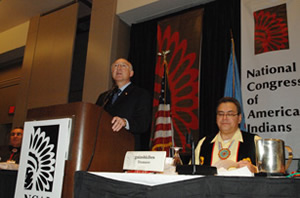 |
The United States infrastructure is talked about a great deal these days, in part because it really is in disrepair and in part because a great deal of money has finally been made available on a wide-scale for much-needed projects. Regardless of how one might feel about this level of government spending, the stimulus packages have certainly thrown light upon projects and segments of the country that have long been overlooked.
Take, for example, American Indian reservations.
In general, when US infrastructure is talked about, one significant portion that is overlooked is the extensive amount of infrastructure needs on the country’s reservation lands. There’s nothing small about this.
The 310 Indian reservations in the United States account for roughly 2.3% (or 55.7 million acres) of the country’s land.
One area being helped by the recent US economic stimulus package is the Indian Reservation Roads (IRR) Program. It’s jointly administered by the Bureau of Indian Affairs and the Federal Highways Administration (FHWA). The Recovery Act allocated $310 million of funding for the IRR (out of a $450 million line for roads and housing).
One example of how these funds are being used is the Citizen Potawatomi Nation working with the city of Shawnee, Oklahoma to mill and resurface roads. Geosynthetic reinforcement is being acquired with stimulus money to provide longer road service life.
A Reservation Superfund?
Reservations enjoy a bit of sovereignty, but it is limited form. As such they exist partly in the United States and partly outside of it. This has at times led to their being passed over in infrastructure funding—particularly when it concerns environmental remediation.
A fair number of natural resources are found on Indian lands. The legacy of pollution from this mining activity is just as severe as anywhere, but the funding for cleanup has not necessarily been there, in part due to questions of sovereignty and final responsibility.
The US Environmental Protection Agency (EPA) has established the Office of Solid Waste and Emergency Response (OSWER) to improve relationships between the US government and tribal nations.
In December 2008, for example, a $1.75 million grant was given to the Northern Arizona University’s Institute for Tribal Environmental Professionals to support a steering committee of tribal co-regulators to work with EPA on solid and hazardous waste cleanup issues. The EPA is also releasing a tribal strategy to advance the protection and restoration of land in Indian country.
Some tribal nations are taking this need upon themselves, though.
The Navajo Nation Council, in early 2008, passed a bill that established a tribal Superfund program to address severe environmental cleanup needs on the Navajo’s 27,000-square-mile reservation that rests on northeastern Arizona, the southeastern portion of Utah, and northwestern New Mexico. The Navajo solution was dearly needed. Consider, for example, that there are approximately 1000 uranium mines on Navajo land that may need cleanup measures.
This seems to be the first tribe-established Superfund program. It’s an important step.
Whether these initiatives are tribal or a partnership between a US federal, state or local agency and a tribe, these initiatives can help rectify a long-overlooked segment of environmental degradation and a significant portion of American infrastructure.
LINKS
Bureau of Indian Affairs
http://www.doi.gov/bia/
Indian Reservation Roads (IRR) Program
http://www.doi.gov/bia/roadreservation.html
OSWER
http://www.epa.gov/oswer/tribal/
Press Release: $1.75 Million Grant…
https://www.geosynthetica.net/news/pressrelease/EPA_TribalGrant_120308.aspx
Chris Kelsey is the editorial director for geosynthetica.net. He can be reached at chris@geosynthetica.net.











